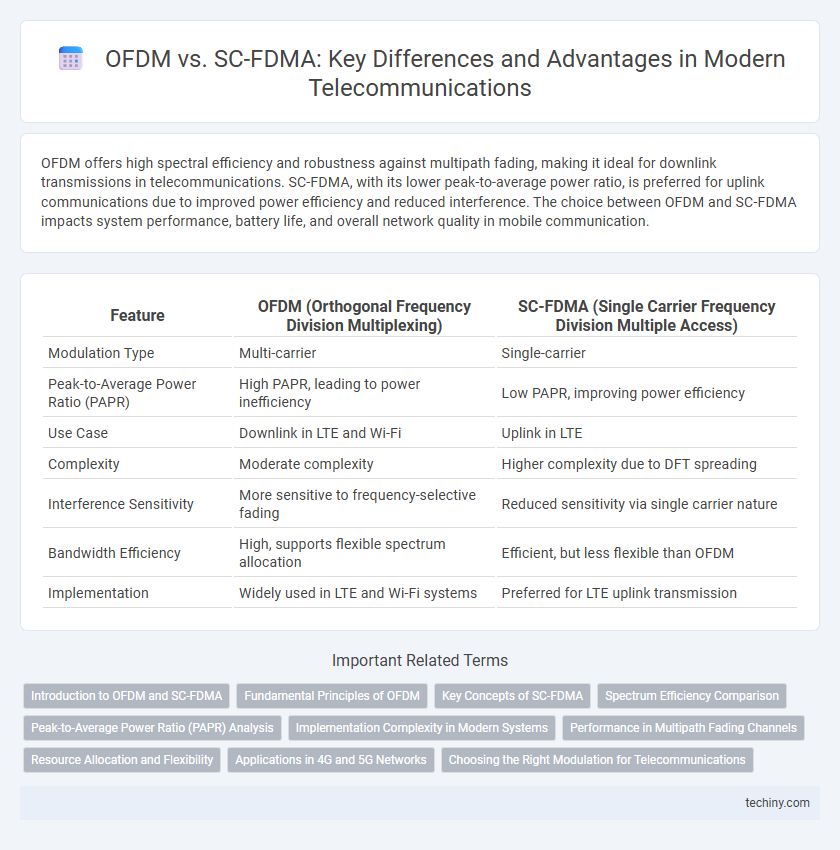OFDM offers high spectral efficiency and robustness against multipath fading, making it ideal for downlink transmissions in telecommunications. SC-FDMA, with its lower peak-to-average power ratio, is preferred for uplink communications due to improved power efficiency and reduced interference. The choice between OFDM and SC-FDMA impacts system performance, battery life, and overall network quality in mobile communication.
Table of Comparison
| Feature | OFDM (Orthogonal Frequency Division Multiplexing) | SC-FDMA (Single Carrier Frequency Division Multiple Access) |
|---|---|---|
| Modulation Type | Multi-carrier | Single-carrier |
| Peak-to-Average Power Ratio (PAPR) | High PAPR, leading to power inefficiency | Low PAPR, improving power efficiency |
| Use Case | Downlink in LTE and Wi-Fi | Uplink in LTE |
| Complexity | Moderate complexity | Higher complexity due to DFT spreading |
| Interference Sensitivity | More sensitive to frequency-selective fading | Reduced sensitivity via single carrier nature |
| Bandwidth Efficiency | High, supports flexible spectrum allocation | Efficient, but less flexible than OFDM |
| Implementation | Widely used in LTE and Wi-Fi systems | Preferred for LTE uplink transmission |
Introduction to OFDM and SC-FDMA
Orthogonal Frequency Division Multiplexing (OFDM) is a multicarrier modulation technique that divides a wideband channel into multiple orthogonal subcarriers, improving spectral efficiency and robustness against multipath fading. Single Carrier Frequency Division Multiple Access (SC-FDMA), used primarily in uplink transmissions such as LTE, combines single-carrier transmission with frequency domain equalization to reduce peak-to-average power ratio (PAPR) while maintaining similar performance to OFDM. Both OFDM and SC-FDMA optimize data transmission over wireless channels, with OFDM widely adopted for downlink and SC-FDMA preferred for uplink to enhance power efficiency in mobile devices.
Fundamental Principles of OFDM
Orthogonal Frequency Division Multiplexing (OFDM) divides the available spectrum into multiple orthogonal subcarriers, enabling efficient parallel transmission and robust resistance to multipath fading and inter-symbol interference. Each subcarrier is modulated with a low-data-rate stream, allowing simpler channel equalization and improved spectral efficiency compared to single-carrier systems. The use of Fast Fourier Transform (FFT) and cyclic prefix in OFDM ensures precise orthogonality and mitigates inter-carrier interference, making it ideal for high-speed broadband wireless communications.
Key Concepts of SC-FDMA
SC-FDMA (Single Carrier Frequency Division Multiple Access) utilizes a single carrier transmission scheme combined with frequency domain equalization to reduce Peak-to-Average Power Ratio (PAPR), enhancing power efficiency in mobile uplink transmissions. Unlike OFDM, SC-FDMA applies a discrete Fourier transform (DFT) precoding step before subcarrier mapping, which results in lower signal distortions and improved battery life for user equipment. Its low PAPR characteristic makes SC-FDMA the preferred multiple access technique in LTE uplink, supporting better coverage and user experience in cellular networks.
Spectrum Efficiency Comparison
OFDM offers higher spectrum efficiency than SC-FDMA by enabling complex adaptive modulation and coding across multiple subcarriers, optimizing data throughput within limited bandwidth. SC-FDMA, while less spectrally efficient due to its single-carrier structure, reduces peak-to-average power ratio, benefiting uplink transmission in LTE systems. The choice between OFDM and SC-FDMA hinges on maximizing spectral utilization versus minimizing power consumption and interference in cellular networks.
Peak-to-Average Power Ratio (PAPR) Analysis
OFDM exhibits a higher Peak-to-Average Power Ratio (PAPR) due to its multi-carrier nature, leading to increased power amplifier inefficiency and signal distortion in telecommunications systems. SC-FDMA mitigates PAPR by utilizing single-carrier transmission with frequency domain equalization, resulting in improved power amplifier efficiency and reduced nonlinear effects. Analyzing PAPR is critical for optimizing modulation schemes in LTE uplink communications and enhancing overall system performance.
Implementation Complexity in Modern Systems
OFDM (Orthogonal Frequency Division Multiplexing) exhibits higher implementation complexity due to its extensive use of FFT/IFFT operations and stringent synchronization requirements, whereas SC-FDMA (Single Carrier Frequency Division Multiple Access) benefits from a simplified transmitter architecture by leveraging a DFT precoding step. Modern cellular standards like LTE employ SC-FDMA in uplink transmissions to reduce peak-to-average power ratio (PAPR), enhancing power amplifier efficiency and easing hardware design constraints. The trade-off in complexity influences system design choices, with OFDM preferred for downlink scenarios where receiver complexity is manageable and SC-FDMA chosen for uplink to optimize battery life and transmitter efficiency.
Performance in Multipath Fading Channels
OFDM offers robust performance in multipath fading channels by dividing the spectrum into narrowband subcarriers, effectively mitigating inter-symbol interference through cyclic prefix insertion. SC-FDMA, while sharing similar resistance to multipath effects, exhibits lower peak-to-average power ratio (PAPR), enhancing power amplifier efficiency and reducing nonlinear distortion in uplink transmission. In scenarios with severe multipath fading, OFDM's frequency-domain equalization provides superior adaptability, whereas SC-FDMA is favored for its improved battery life and signal quality in mobile devices.
Resource Allocation and Flexibility
OFDM offers superior resource allocation granularity through its ability to assign individual subcarriers to multiple users, enhancing spectral efficiency and flexibility in multi-user environments. SC-FDMA, used predominantly in LTE uplink, provides lower Peak-to-Average Power Ratio (PAPR) but restricts resource allocation to contiguous subcarriers per user, limiting its flexibility compared to OFDM. This contiguous allocation in SC-FDMA ensures reduced signal distortion but results in less dynamic frequency resource distribution.
Applications in 4G and 5G Networks
OFDM is widely used in 4G LTE downlink channels due to its robustness against multipath fading and high spectral efficiency, enabling high data rates in dense urban environments. SC-FDMA, favored in 4G LTE uplink transmissions, offers lower peak-to-average power ratio (PAPR), resulting in improved power efficiency and extended battery life for mobile devices. In 5G networks, OFDM continues to support diverse services with flexible numerology and massive MIMO integration, while SC-FDMA variants are explored for uplink scenarios demanding low latency and energy-efficient transmissions.
Choosing the Right Modulation for Telecommunications
OFDM offers superior spectral efficiency and robustness against multipath fading, making it ideal for high-data-rate downlink transmissions in 4G and 5G networks. SC-FDMA provides lower Peak-to-Average Power Ratio (PAPR), which enhances power efficiency and extends battery life, benefiting uplink communications in mobile devices. Selecting the appropriate modulation scheme hinges on balancing system complexity, power consumption, and channel conditions for optimal network performance.
OFDM vs SC-FDMA Infographic

 techiny.com
techiny.com